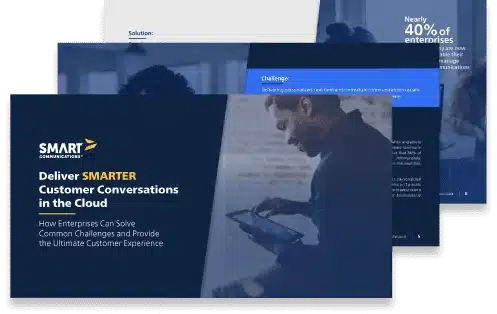Driving Better Outcomes in Workers’ Compensation
By: Ruth Fisk, VP Insurance Strategy at Smart Communications
Reimagining communications is critical to controlling costs and improving business outcomes
For many years, digital transformation has been a common strategic initiative, spanning just about every industry. But unfortunately, insurance has been slow to the game. At the same time, increasing costs, complexity and regulations are making insurance processes more complicated and compliance more critical, while consumer expectations for seamless digital experiences are extending into more traditional businesses like insurance. More than being compared simply to one another, today’s insurers are competing with every customer’s last, best experience with digital-first companies like Uber, Instacart, Waze and others. The time is now for the industry as a whole to take a more innovative approach.
When it comes to workers’ compensation insurance, insurers need to look for new, more digitally-driven ways to manage claims and control costs. In addition to supporting better life outcomes for injured workers, processing claims in a more efficient, timely manner enables insurers to drive better business outcomes—for both the injured worker and the employer.
There are a number of areas within workers’ compensation where insurers can streamline processes, including:
- Accelerating initial reporting processes
- Increasing claimant responsibility through self-determination programs
- Enhancing information and analytics for treatment plans
- Focusing on rehabilitation, as well as more preventative measures, and increased loss control
Every facet of this forward-thinking approach centers on one key aspect of the interaction: interactive, two-way conversations. In workers’ compensation, every customer touch point is critical. In this high-stakes, emotional and stressful situation, insurers have an opportunity to build trust and make processes smooth, efficient, fast and empathetic.
Let’s look at how improved, digital-first interactions drive better outcomes for everyone involved in a workers’ compensation claim.
Supporting the Injured Worker
Being injured on the job creates difficulties on multiple fronts. In addition to dealing with the stress of a medical situation and all that entails, including pain, discomfort, appointments, recovery time and more, injured workers are worried about the impact the incident will have on their lives. Will they have the ability to support their family? When will they be able to return to work? How will they manage a short- or long-term loss of income?
To minimize stress for the injured worker and help them achieve the best possible personal outcomes as swiftly as possible, claims processes need to be simplified and decisions must be expedited. Digitizing processes and turning static, manual tasks into dynamic, two-way interactions simplifies every step of the claims process and accelerates the path to decisions and settlement, as well as rehabilitation and recovery.
If an injured worker has the right support from their employer and insurer, they can rest easy knowing their income stability will not be jeopardized while they recover from their injury. Digital-first, interactive conversations help to establish this faster, reducing stress during an already stressful time. The medical support they receive will also help them return to work faster—which is ultimately what they want to do.
Improving communications between the injured worker and recommended healthcare providers makes it easier for them to get the care they need to recover. Injured workers should be able to make their own choices about care. This puts them in control of planning their path to rehabilitation and taking responsibility for the return-to-work plan. Opening the pathways of communication between the insurer, the injured worker and the care team empowers claimants and allows them to take this vital control.
Enabling Greater Efficiency for Employers
When a workplace injury occurs, time is of the essence. Employers must report the injury quickly to maintain compliance with regulatory bodies, and also to minimize the costs. Rapid response helps mitigate additional medical costs as well as potential litigation. And delayed reporting can significantly increase workers’ compensation claims costs. Expediting the claim also helps to get the injured worker back to work faster, minimizing productivity and operational continuity losses.
Employers should have the ability to report a claim easily and securely. They should be able to actively participate in reporting the claim as well as in the worker’s rehabilitation and eventual return-to-work plan. Giving employers this ability calls for a reimagining of processes, systems and technology. It requires new solutions that replace outdated, paper-based processes with dynamic, digital interactions.
When employers have the right solutions, they can play an active role in rehabilitation and recovery, helping to improve outcomes for their valued employees as well as for the business as a whole. Workers’ compensation claims management processes are highly regulated and when employers lack solutions that ensure those processes are strictly adhered to, the regulatory cost can be extremely high. Choosing a system that optimizes and simplifies the complexity of communications between all involved parties is critical to success—and to avoiding regulatory fines and expenses.
Improved communications also help employers close claims more quickly. More than half of claims that are reported within the first two weeks close within 18 months. However, only 29% of claims that are reported more than a month after the accident close within the same timeframe.
Empowering Medical Providers for Improved Care
In any workers’ compensation claim, the medical provider plays a key role in recommending what rehabilitation must take place for the worker to return to the job. To expedite claim resolution—and recovery/return to work for the injured employee—medical providers must be able to share information more efficiently and securely.
Improving communications between medical providers and the injured worker, the employer and the case manager all help to expedite claim resolution/return to work and produce better results for all. Replacing manual, analog modes of communication, such as telephone and paper-based forms, with a digital-first approach allows medical providers and case managers to share information quickly, easily and securely. The insurance company’s chief medical officer should be able to seamlessly collaborate with providers to ensure adherence to best practices and facilitate optimal care for the injured worker.
Evidence-based medicine is the cornerstone of the information flow that enables all involved parties to accelerate claim resolution. Being able to share data-driven information with the physician about the most effective treatment plan for similar historical injuries can help providers make an evidence-based recommendation.
A digital-forward solution makes it easy for the physician to upload key information like Certificate of Capacity, medical records, x-ray images and other documents automatically during a guided interview. This information can then be pushed to the claim system (such as Guidewire ClaimCenter) to expedite resolution. Being able to automatically send information to the injured worker’s mobile device as they are leaving the doctor’s office can also help keep their recovery on track and get them back to work sooner. Whether treatment plans, expected return to work data, possible community meetings for similar injuries, or other information, medical providers can serve as a powerful resource encouraging patient progress.
Improving the Options for Case Managers
Case managers are key in streamlining the end-to-end claims management effort. Having access to the right information at the right time can greatly impact the overall process, experience, and outcomes—for both the worker and the employer. Seamless communications between all sources of information (employer, injured worker, care team) and the case manager results in faster claims resolution and happier customers. From collecting initial injury and claim information, to sharing evidence-based medical information with the provider, to keeping the employer in the loop about the expected return-to-work date so they can plan accordingly, an effective case manager can expedite resolution and minimize costs for the insurer.
In addition to improving communications, digitizing processes can help case managers get ahead of potential complications, further mitigating costs and risk. Predictive analytics allow claim managers to identify potential complicating factors about an individual’s condition up front. This enables case managers to take these risks into account from the beginning and create a more proactive approach to the injured party’s ongoing treatment plans.
New technology solutions that are purpose-built for today’s world can transform case management. By automating and digitizing outdated processes, empowering case managers to get the information they need, when they need it, streamlining claims management at every stage and enabling them to drive improved outcomes for all, technology will be instrumental in improving effectiveness.
Driving to Digital with the Conversation Cloud
The Smart Communications Conversation Cloud allows workers’ compensation insurers to turn static forms and disjointed communications into dynamic, on-demand conversations across the entire claims lifecycle. At every stage, improving communications between all involved parties helps to minimize expenses, accelerate resolution and recovery and improve both business and life outcomes.
With pure cloud solutions that integrate with existing systems and infuse intelligence into every step, insurers can dramatically simplify processes to expedite decisions, facilitate faster resolution and make the experience better for everyone. The Conversation Cloud makes it easy to prepopulate forms for more personalized interactions and use automation to boost case manager productivity, while also keeping recovery on track. By harnessing the power of automation to improve communications, maintain compliance and enhance the claims experience and outcomes, insurers have a powerful opportunity for improving workers’ compensation outcomes.
A Time for Progress
The insurance industry has been weighed down by slow, paper-based, disjointed processes for too long. Now is the time for insurers to embrace innovation and take a new approach to workers’ compensation claims management and resolution. For workers’ compensation claims, interactive conversations are the key to creating a better experience, reducing stress and improving the end result for everyone involved.
SMART technology accelerates resolution and minimizes losses for the insured. It has the power to help expedite recovery and improve life outcomes for the injured worker. And the bottom-line benefits of streamlining processes, maintaining compliance and minimizing expenses for the insurer are unmistakable. Adopting a digital-first solution and replacing one-way interactions with dynamic, two-way conversations helps workers’ compensation insurers improve interactions at every step and deliver better results for everyone.
Find out what the Smart Communications Conversation Cloud can do for your business and contact us today.



